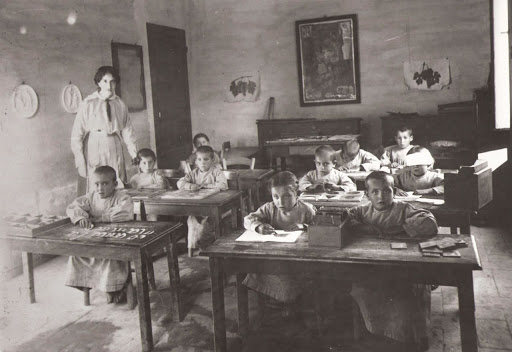 |
| The Montessori school in Villa Montesca, 1909 |
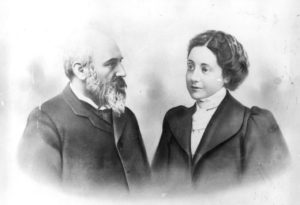 |
| Baron Leopoldo Franchetti and Baroness Alice Hallgarten |
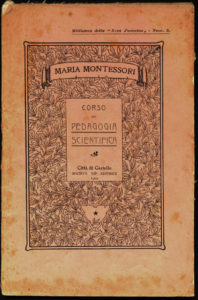 |
| Corsa di Pedagogia Scientifica publication |
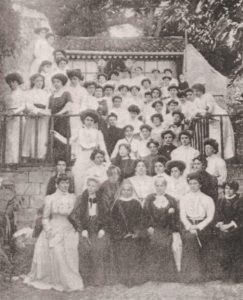 |
| The participants of the first Montessori training course in Villa Montesca, Città di Castello |
Following this, on August 1909, Dr. Montessori gave her first ever training Corso di Pedagogia Scientifica (Scientific Pedagogy Course) which was attended by about seventy participants, including teachers and some local education authorities, with each of them receiving a copy of her book. In the inauguration, baron Franchetti said: “I have the honour to present Dr. Montessori who came among us to attend this course – the fruits of her studies have advanced education along the path that was opened by the great educators of the past centuries…” 3
With the success of the book and the first training course, interest grew, the following year two courses were held in Rome; one, under the patronage of Queen Margherita, at the Franciscan Missionaries of Mary in Via Giusti, and the other, promoted by the Italian National Council of Women, at the primary school ‘E. Foa Fusinato’.
Later Dr. Montessori writes: “I was left in the dark, without help, no one to lift me, to support me in this human labour… Many visited the Children’s
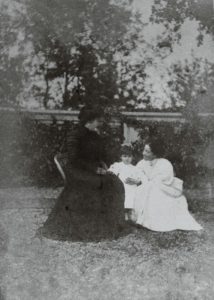 |
| Dr. Maria Montessori, Alice Hallgarten and a young child at Villa Montesca |
House to restore themselves in the spiritual bath, but only the Baroness Franchetti understood that this water would invigorate humanity.” 4
Sadly, all of this ends very quickly when Alice Hallgarten experiences a sudden death on October 22, 1911, and following this, broken and unable to bear the pain, baron Franchetti commits suicide six years later.
Later in 1913 when the first English edition of Il Metodo della Pedagogia Scientifica applicato all’ educazione infantile nelle Case Dei Bambini was published under the shorter title of ‘The Montessori Method’, Dr. Montessori gives special recognition to Hallgarten saying ‘To the dear memory of Baroness Alice Franchetti’, since an English publication of the book was something Hallgarten had longed to see before she died.
In fact, the Italian writer Sofia Bisi Albini says ‘without the impulse given by Baroness Alice Franchetti, perhaps the ideas of Maria Montessori would have reached the world slower’.
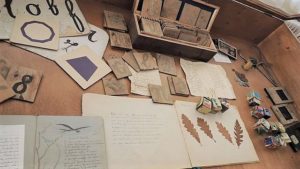 |
| Photo taken by Cavini of the Montessori didactic materials that were once used in Villa Montesca, Città di Castello |
Sources:
1 Franchetti, L. & Sonnino, S. (1876) La Sicilia nel 1876 Firenze: Vallechi
2 Trabalzini, P. (2011) Maria Montessori through the seasons of the “method” Cleveland, OH: NAMTA Journal
3, 4 Cavini, D. (2013) Storia di Alice che fu la talent-scout di Maria Montessori Città di Castello: Pioniere dell’educazione
 Sid Mohandas is a Montessori teacher and teacher trainer. He founded The Male Montessorian, as a platform to grapple with the complexities of gender within early childhood spaces. He completed his Montessori training at Montessori Centre International (MCI), London. Later pursued qualifications in Early Childhood Education with London Metropolitan University and his Master’s in Early Childhood Education at the Institute of Education, UCL. Sid is currently doing his PhD on reconfiguring gender of the early years workforce using posthuman theories.
Sid Mohandas is a Montessori teacher and teacher trainer. He founded The Male Montessorian, as a platform to grapple with the complexities of gender within early childhood spaces. He completed his Montessori training at Montessori Centre International (MCI), London. Later pursued qualifications in Early Childhood Education with London Metropolitan University and his Master’s in Early Childhood Education at the Institute of Education, UCL. Sid is currently doing his PhD on reconfiguring gender of the early years workforce using posthuman theories.